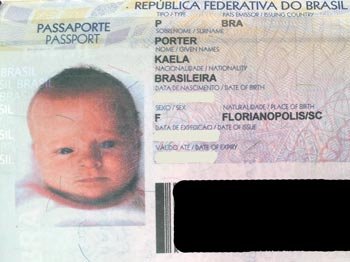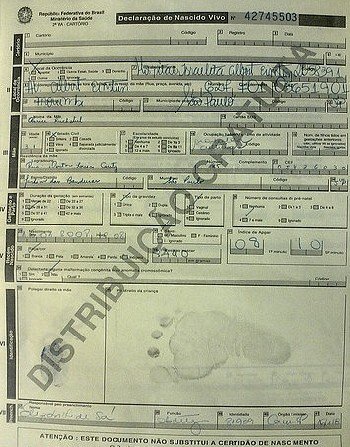
By daughter’s Brazilian passport
I’ll never forget holding my swaddled little baby girl for the first time while gazing over the beach from our apartment window.
As I was looking at her, a culmination of feelings hit me but one main feeling stood out above others: “This little girl is beautiful…and she’s Brazilian!”
Then the sense of accomplishment hit me like a ton of bricks, all of these months of planning and hard work to make that one moment happen were over… and the mission was accomplished – we had a Brazilian child.
So the hardest part was over and the next steps would be a piece of cake compared to what we had to go through to figure out everything alone – which you hopefully wont have to with this guide I’ve made for you.
After having gone through these next steps, I’ve decided to share them with you today.
Here they are:
- Get a birth certificate.
- Get a passport for the baby.
- Apply for residence.
Note: if you haven’t read any of the previous posts in this series, I would recommend that you check out the main page first
Note 2: your baby receives citizenship upon birth regardless of the parents’ citizenship!
Let’s do this!
Getting a Brazilian Birth Certificate for Your Baby
When your baby is born, the hospital you are staying at will fill out a yellow form called a “Declaração de Nascimento Vívo” (Declaration of Live Birth) that looks like the below example.

“Ficha amarela” Live Birth Declaration
This document is referred to locally as the “ficha amarela” (yellow form) as it used to always be yellow, it has since changed color to white.
Within the document it contains all of the necessary information about your baby’s birth to get your birth certificate – including an imprint of your baby’s foot for proof.
After you have this document from the hospital, then you are ready to get the Brazilian birth certificate.
The next part has to be done at a “cartório” (notary public).
What to do at the “cartório” (notary public)
In Brazil, all birth certificates are offered free of charge at the cartórios but there are a few things you will need to make sure to have in place before you go:
- 2 Brazilian witnesses
- The baby.
- The mother and father.
- Your CPF numbers
- Proof of residence
The first 4 of 5 are pretty straight forward: you need 2 Brazilian to vouch for the child’s birth, the baby (obviously), the mother and father, your CPF numbers and a proof of residence.
A cartório must be within your jurisdiction, i.e. you can’t just choose any old cartório and go with it, it must be the one that has jurisdiction over the city you live in.
The most difficult of the 5 is the CPF number and proof of residence.
I have a guide for getting your CPF Number here but here’s a little explanation about the proof of residence.
A proof of residence can be a notarized letter with your CPF number on it from your landlord stating you reside there, a utility or cell phone bill with your name on it or the like.
Chances are that if you are in Brazil on a tourist visa or the like, you will need to go with the landlord proof of residence route.
But the proof of residence must be notarized from the cartório where your landlord has his signature on file!
As soon as you have all of the above 5 requirements together, you just show up at the cartório and ask them to process the birth certificate.
After a few minutes and a few stamps and signatures – viola!, you now have your baby’s birth certificate

My daughter’s birth certificate (with some info removed obviously)
With this Brazilian birth certificate, a whole new world of opportunities have just opened for you and your child – congratulations!
Getting a Passport at the Policia Federal
If you are planning on travelling back to your home country to then come back at a later time or to visit and show off your new little one, you’ll need a passport.
Getting the passport is pretty straight forward compared to a normal passport and only takes about a week or so.
You apply at your local Polícia Federal and pick it up when it’s ready there as well.
There is one major difference when applying for a baby’s passport compared to an adult or child one: you must provide your own picture of your baby, they will not take one for you.
How to take and make a baby passport picture
Here are a few simple steps to do it yourself:
- Take a clear headshot with your camera on a white background with no head coverings (see my baby’s picture in the top of this post).
- Go to , choose “Brazil”, upload the picture and create the image
- Save it onto a CD/DVD or SD card.
- Bring it to a store that prints pictures and you can either choose to print passport pictures on the machine or ask the attendant to help you.
- Use that final picture for the passport application.
When applying for a passport, you will first need the documentation at , which includes printing out a form and paying the passport fee at any Banco do Brasil:
After you have paid the fee and have proof of it, you take a number at the Polícia Federal reception desk and wait your turn.
As soon as it’s your turn, you sit down with an officer, submit your application with proof of payment, birth certificate and the picture.
It will then be processed and you should receive a letter in the mail telling you that your passport is ready.
You can count on it taking at least 1 week to come through but there are expedited services if needed.
Applying for Residence Based on a Brazilian Dependent
In this part of the post, I’ll give you a rundown of must know information and cover the actual step-by-step how to in another post (too long for this post).
Now that you have a Brazilian child, you can stay in Brazil as long as you want regardless of your current , citizenship or criminal background (if you have one)!
And to top it off, you will get official work permission too (Carteira de trabalho).
Residency based on a Brazilian child is one of the only two Visa types that can be applied from within Brazil – I.e. you can switch visas without having to leave the country.
Moreover, there is one extremely important piece of information that you must know: you CANNOT apply for this visa from the outside of Brazil, it must be done from within the country.
The Process of Applying for Permanent Residence Based on a Brazilian Child
You can either:
- Apply directly at the Polícia Federal within your jurisidiction or
- Use a visa agency from within Brazil (like ).
- Apply from an embassy in your country of residence (some don’t allow this).
The advantage of applying in person is that you will save money but then you will have to deal with the bureaucracy involved. Whereas if you use a visa agency from within Brazil, they have connections and will make it happen faster.
When you apply for permanent residence based on a Brazilian child, you will get a “protocolo”, which is basically a piece of paper that has your protocol number that will be used as temporary ID until your visa goes through.
With this protocol document, you can use it to re-enter the country, as ID instead of a RNE (A foreign Brazilian identity card) in order to open a bank account and other things that require Brazilian ID.

An example of a protocol document.
Be aware that not all places accept the protocol document as a substitution and that’s where it can get tricky to get things done as your visa process can take up to several years (though probably less if you use a visa agency from within Brazil).
I personally know someone who waited 3 years for her permanent visa based on a Brazilian child to come…. During the long waiting period, she used the protocol to get around.
Like I said before, there is much more to applying for your permanent visa then above and I will write a dedicated blog post on it soon.
Final Words
It was tough to get the must knows after birth into one post and I hope that what you needed to know was included, if not then please ask.
Feel free to ask anything below in the comments section for other’s to benefit too. If it’s too personal, then feel free to contact me.
Cheers – valeu!
Kevin
P.S. give this a thumbs up if it was helpful ![]()
Posts from the Giving Birth in Brazil series:
- Part 1: Planning to Have a Baby in Brazil – What You Must Know
- Part 2: Choosing a City, Housing + logistics
- Part 3: Finding a Doctor and a Hospital to Give Birth
- Part 4: All About Pricing when Giving Birth
- Part 5: All About Insurance When Giving Birth
- Part 6: Before and During Birth – Getting Ready and What to Expect
- Part 7: After Giving Birth, Here’s What You Do Next
- Part 8: Having Our Baby in Brazil – A Success Story

